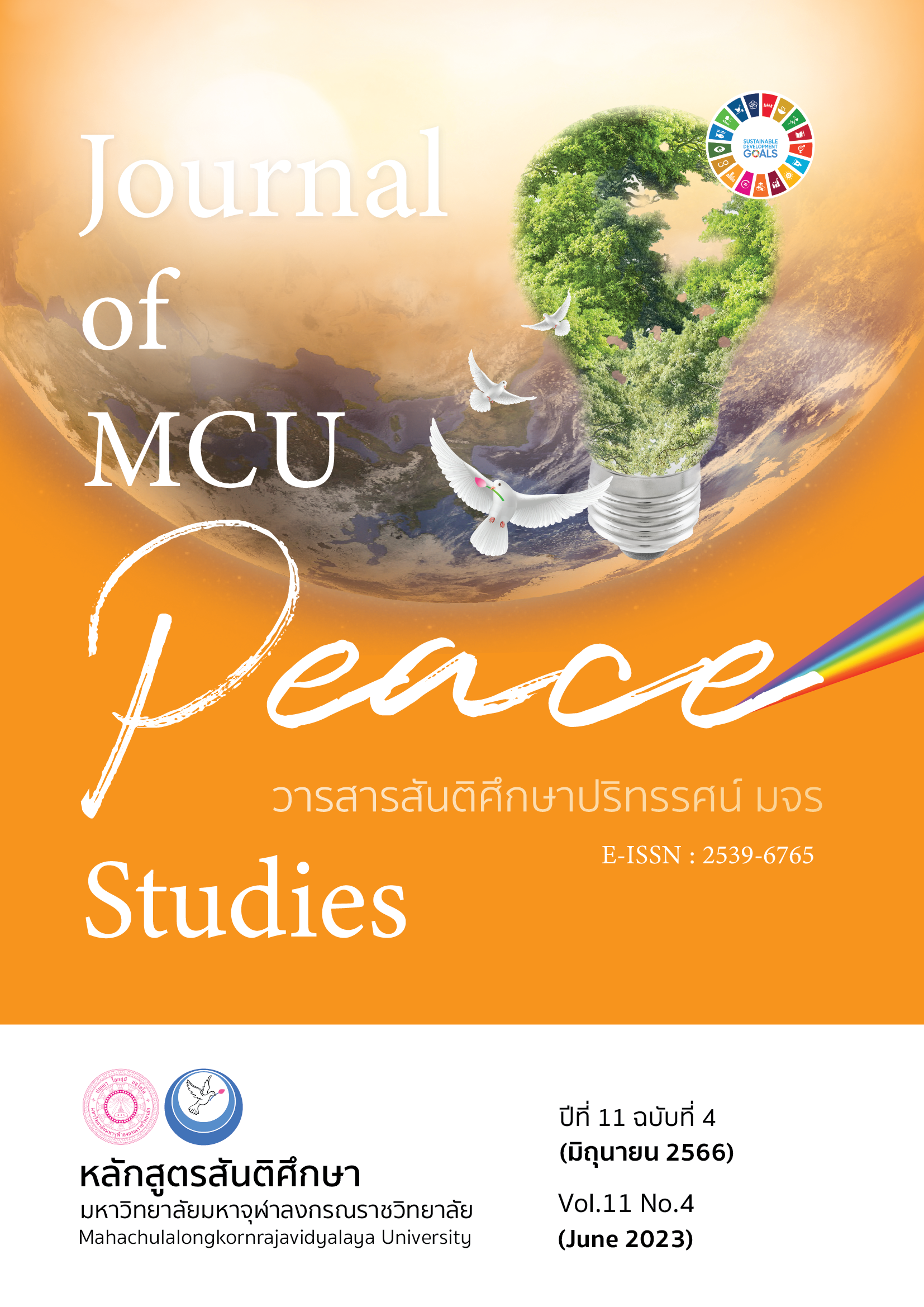การเสริมสร้างพลังเครือข่ายภาคประชาชนเพื่อขับเคลื่อนเมืองพหุวัฒนธรรมแห่งความสุข
Main Article Content
บทคัดย่อ
บทความวิจัยนี้มีวัตถุประสงค์ 1) เพื่อพัฒนาการเสริมสร้างพลังเครือข่ายภาคประชาชนขับเคลื่อน เมืองพหุวัฒนธรรมแห่งความสุขในจังหวัดพระนครศรีอยุธยา 2) เพื่อนำเสนอกลไกการเสริมสร้างพลังเครือข่ายภาคประชาชนเพื่อขับเคลื่อนเมืองพหุวัฒนธรรมแห่งความสุขในจังหวัดพระนครศรีอยุธยา ใช้รูปแบบวิจัยเชิงปฏิบัติการแบบมีส่วนร่วม ผู้ให้ข้อมูลสำคัญเข้าร่วมโครงการวิจัยเชิงปฏิบัติการ คือ กลุ่มแกนนำพลเมืองอาสา 20 คน และเครือข่ายในพื้นที่ 10 ตำบล ของอำเภอพระนครศรีอยุธยา จังหวัดพระนครศรีอยุธยา เครื่องมือการวิจัยที่ใช้ ได้แก่ การสนทนากลุ่ม การจัดกิจกรรมเชิงปฏิบัติการ การถอดบทเรียนด้วยเทคนิคทบทวนหลังปฏิบัติงาน (AAR) การดำเนินกิจกรรมโครงการแบบมีส่วนร่วม วิเคราะห์ข้อมูลด้วยการวิเคราะห์เนื้อหา
ผลการวิจัยพบว่า 1) การพัฒนาการเสริมสร้างพลังเครือข่ายภาคประชาชนขับเคลื่อนเมืองพหุวัฒนธรรมแห่งความสุขในจังหวัดพระนครศรีอยุธยา ประกอบด้วย 4 ระยะ (1) เตรียมคน เตรียมข้อมูล วิเคราะห์บริบทการรับรู้ความสุขในจังหวัดพระนครศรีอยุธยา (2) ปฏิบัติการพัฒนาเสริมสร้างพลังผู้นำอาสาสร้างเครือข่ายแบบมีส่วนร่วม (3) ปฏิบัติขับเคลื่อนแผนสู่การปฏิบัติกิจกรรมสร้างสรรค์เมืองพหุวัฒนธรรมแห่งความสุขด้วยการเสริมสร้างพลังเครือข่าย (4) เหลียวหลังแลหน้า ทบทวนการทำงานและวางแผนรวมพลังเครือข่ายขยายพื้นที่แห่งความสุข 2) กลไกการเสริมสร้างพลังเครือข่ายภาคประชาชน เพื่อขับเคลื่อนเมืองพหุวัฒนธรรมแห่งความสุขในจังหวัดพระนครศรีอยุธยา มี 5 หลักการที่สำคัญ 1) การร่วมกลุ่มแกนนำอาสา 2) การร่วมเรียนรู้เพื่อการเปลี่ยนแปลง 3) การร่วมปฏิบัติการสร้างสุขในชุมชน 4) พลังแห่งการร่วมสื่อสารติดตามขยายเครือข่าย 5) การมีกัลยาณมิตรบนฐานคิดการใช้วิจัยเพื่อพัฒนาชุมชน องค์ความรู้จากการวิจัย คือ โมเดล “PAR SUK: สานพลังผู้นำอาสา สร้างการมีส่วนร่วมเมืองพหุวัฒนธรรมแห่งความสุข” PAR-Participatory หมายถึง การดำเนินโดยใช้หลักการมีส่วนร่วม SUK (สุข) หมายถึง เมืองพหุวัฒนธรรม แห่งความสุขที่ครอบคลุมทั้ง 4 ด้าน คือ จิตภาพ ปัญญาภาพ กายภาพ และสังคมภาพ ด้วยวงจร 4 ขั้น คือ 1) พลังแห่งการร่วมกลุ่มผู้นำอาสา 2) พลังแห่งการร่วมเรียนรู้เพื่อการเปลี่ยนแปลง 3) พลังแห่งการร่วมปฏิบัติการสร้างสุขในชุมชนด้วยเครือข่ายผู้นำอาสา 4) พลังแห่งการร่วมสื่อสารติดตามขยายเครือข่าย
Article Details

อนุญาตภายใต้เงื่อนไข Creative Commons Attribution-NonCommercial-NoDerivatives 4.0 International License.
ทัศนะและความคิดเห็นที่ปรากฏในบทความในวารสาร ถือเป็นความรับผิดชอบของผู้เขียนบทความนั้น และไม่ถือเป็นทัศนะและความรับผิดชอบของกองบรรณาธิการ ยินยอมว่าบทความเป็นลิขสิทธิ์ของวารสาร
เอกสารอ้างอิง
Dasri, C., Pimpo, P., Iammnok, K., & Srikan, N. (2020). Lesson Learnt from Human Capital Development by the Project of “Sa Kaeo Happiness City” in Sa Kaeo Province. Mahachula Academic Journal, 7(1) 232-246.
Helliwell, J. F. et al. (2022). World Happiness Report 2022. New York: Sustainable Development Solutions Network, 2022. Retrieved October 10, 2022, from https://worldhappiness.report/archive/
Kittapraphat, S. (2022). Gross Happiness or Social Well-Being: Public Policy that Thai People Must Jointly Create. Retrieved August 2, 2022 from http://www.happysociety.org/uploads/HsoDownload/4/download_file.pdf
Laverack, G. (2007). Health Promotion Practice: Power and Empowerment. London: Sage Publications.
National Statistical Office Ministry of Digital Economy and Society. (2021). The Results of the Mental Health (Happiness) Survey Summary of People in Thailand 2020. Bangkok: Bangkok Blog Limited Partnership.
Office of the National Economics and Social Development Council. (2022). Regional and Provincial Products in Chain Quantity, 2018 Edition. Retrieved September 20, 2022, from https://www.nesdc.go.th/ewt_dl_link.php?nid=5628&filename=gross_regional
Pattamasang, A. (2022). The Moral Center (Public Organization), Moves Forward with the Moral Provincial Model, Preparing to Launch 4 Moral Provinces, Phase 2. Retrieved September 20, 2022, from https://www.moralcenter.or.th
Phrakhrusoontornwatcharakan, & Phrakhruwiroonwatcharadham. (2020). Happiness Community: Process of the Citizen Consciousness Learning of the Community by Using Community as a Social Lab. Journal of Yanasangvorn Research Institute, 11(1), 1-12.
Phramaha Suthit Apakaro, & Intharasuwan, K. (2010). Sustainable Community Happiness Indicators. Bangkok: Institute of Learning Promotion for Happy Community.
Phramahawichai Vachilatammo et al. (2020). Enhancing Public Awareness and Network Management of the Creative Community in Thailand. (Research Project). Buddhist Research Institute of MCU: Mahachulalongkornrajavidyalaya University.
Prukkanone, B. et al. (2022). Happiness in Thai Population: A 2018 National Survey Analysis at Provincial Level. The Journal of Mental Health of Thailand, 30(1), 75-86.
Secretary Office of National Strategy board. (2021). National Strategy 2018 – 2037 (Short Version). Retrieved May 3, 2021, from https://www.nesdc.go.th/download/document/SAC /NS_ SumPlanOct2018.pdf
Sisabai, S. (2021). Lesson Learned from the Research Area: Strengthening Social Network to Recluse Risk Factors according to Buddhism in Klong Krathing Community, Samut Songkram Province. Journal of Buddhist Innovation and Management, 4(1), 74-88.
Tanyuwattana, T., & Naruepatr, J. (2022). Empowering Volunteer Network Through Social Capital: Case Study on the Role of the Officials from the National Civil Affairs Department. Continuing Report of the Academic Seminar on the Occasion of the Establishment of the Faculty of Social Administration, Thammasat University, Year 65. Retrieved January 20, 2022, from https://socadmin.tu.ac.th/uploads/socadmin/file_document/1.2
Wallerstein, N., & Bernstein, E. (1994). Introduction to Community Empowerment Participatory Education and Health. Health Education Quarterly, 21(2), 141-148.
Wikipedia. (2022). List of Provinces in Thailand Sorted by Provincial Product. Retrieved August 2, 2022, from https://www.shorturl.asia/C8hTK


